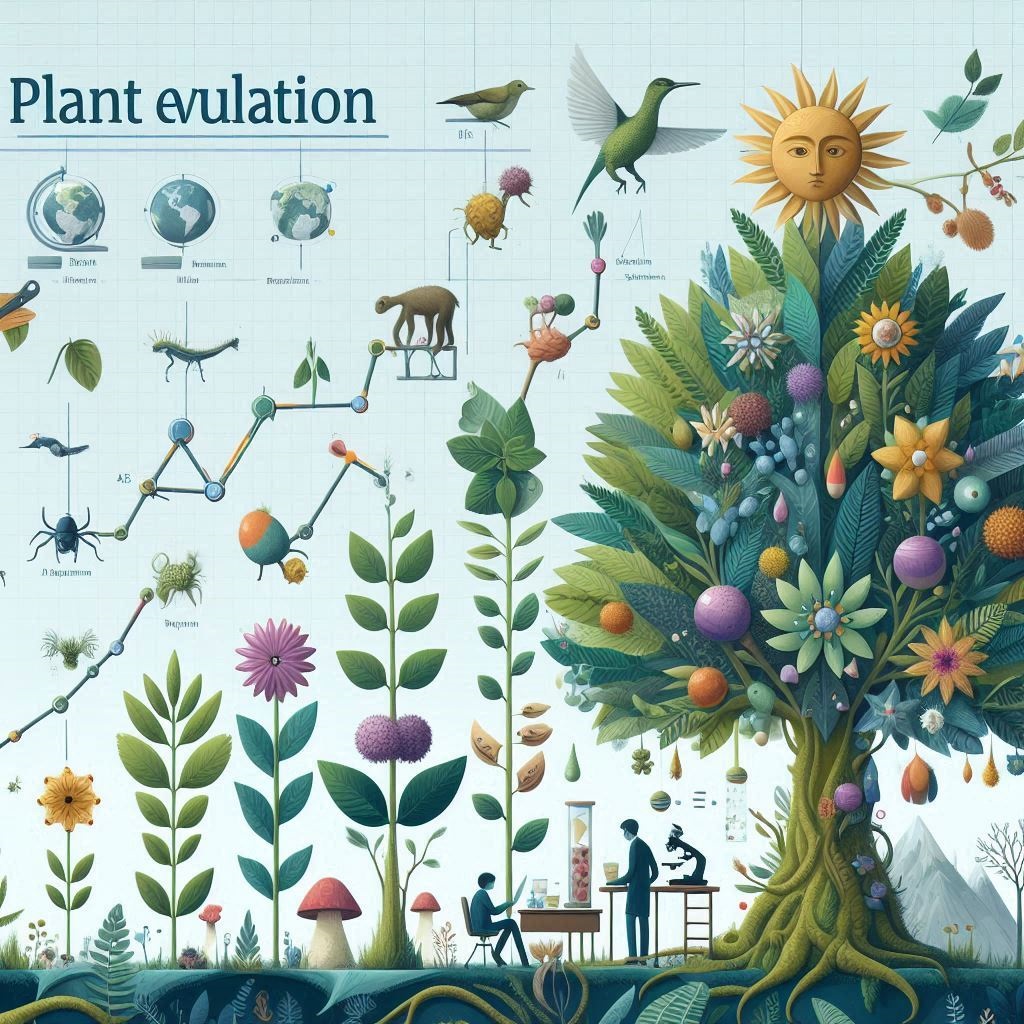Plant Evolution: A Journey Through Time
Plant evolution is a fascinating saga that spans over 500 million years, marked by significant adaptations and diversifications that have shaped the Earth’s landscapes and ecosystems. This article delves into the evolutionary history of plants, exploring key developments and their impacts on life as we know it.
The Origin of Plants
The story of plant evolution begins in the ancient oceans, where the earliest plants evolved from green algae. These primitive organisms were simple, single-celled photosynthetic eukaryotes. The transition from aquatic to terrestrial environments was a monumental step in plant evolution, enabling them to colonize new habitats and diversify into various forms.
Bryophytes: The First Land Plants
The bryophytes, which include mosses, liverworts, and hornworts, are considered the first true land plants. Emerging around 500 million years ago, bryophytes lack vascular tissue, which limits their size and ability to transport water and nutrients. Despite these limitations, bryophytes represent a crucial step in plant evolution, demonstrating the initial adaptations required for life on land, such as cuticles to prevent desiccation and rhizoids for anchorage.
The Rise of Vascular Plants
Approximately 420 million years ago, vascular plants emerged, possessing specialized tissues (xylem and phloem) for water and nutrient transport. This advancement allowed plants to grow taller and more structurally complex, leading to the development of extensive root and shoot systems. Early vascular plants, such as the lycophytes and ferns, dominated the ancient landscapes, forming the first extensive forests.
Seed Plants: Gymnosperms and Angiosperms
The evolution of seed plants marked a significant turning point in plant history. Seeds provide a protective environment for the developing embryo, enhancing survival and dispersal capabilities. Gymnosperms, including conifers, cycads, and ginkgoes, were the first seed plants to appear around 360 million years ago. These plants produced naked seeds not enclosed in fruits.
Angiosperms, or flowering plants, emerged around 140 million years ago and quickly became the most diverse and widespread group of plants. Angiosperms possess flowers and fruits, which aid in pollination and seed dispersal. Their coevolution with pollinators, such as insects and birds, has contributed to their remarkable diversity and ecological success.
Major Innovations in Plant Evolution
Throughout the evolutionary history of plants, several key innovations have driven their success and diversification. These adaptations have enabled plants to colonize new environments, thrive under various conditions, and interact with other organisms in complex ecosystems. Here are some of the most significant innovations in plant evolution:
- Photosynthesis: The ability to convert sunlight into chemical energy through photosynthesis is fundamental to plant life. This process, which takes place in chloroplasts, allows plants to produce their own food and release oxygen as a byproduct, supporting life on Earth. The evolution of photosynthetic machinery was a pivotal moment in the history of plants and life as a whole.
- Cuticle and Stomata: The development of a waxy cuticle helped plants reduce water loss and survive in terrestrial environments. Stomata, tiny openings on the surface of leaves and stems, regulate gas exchange and water vapor, allowing plants to control transpiration and photosynthesis efficiently.
- Vascular Tissue: The evolution of xylem and phloem, the vascular tissues, enabled plants to transport water, nutrients, and sugars throughout their bodies. Xylem transports water and minerals from roots to shoots, while phloem distributes the products of photosynthesis from leaves to other parts of the plant. This innovation allowed plants to grow taller and develop complex structures.
- Roots and Shoots: The differentiation of plant bodies into roots and shoots facilitated efficient nutrient and water uptake from the soil and optimized light capture for photosynthesis. Roots anchor plants in the soil and absorb water and nutrients, while shoots, including stems and leaves, grow above ground to maximize exposure to sunlight.
- Seeds: The development of seeds was a major evolutionary milestone that provided protection and nourishment for the developing embryo. Seeds can remain dormant under unfavorable conditions and germinate when conditions improve, enhancing plant survival and dispersal capabilities. Seed plants, including gymnosperms and angiosperms, diversified widely due to this adaptation.
- Flowers and Fruits: The evolution of flowers and fruits in angiosperms, or flowering plants, revolutionized plant reproduction. Flowers attract pollinators, facilitating efficient pollen transfer and genetic diversity. Fruits protect developing seeds and aid in their dispersal by attracting animals that consume the fruit and spread the seeds.
- Symbiotic Relationships: Plants have evolved numerous symbiotic relationships with other organisms that enhance their survival and growth. For example, mycorrhizal fungi form mutualistic associations with plant roots, improving nutrient uptake, while nitrogen-fixing bacteria in root nodules of legumes convert atmospheric nitrogen into forms plants can use.
- Secondary Metabolites: Plants produce a wide range of secondary metabolites, such as alkaloids, terpenoids, and flavonoids, which play roles in defense against herbivores, pathogens, and UV radiation. These compounds also have ecological functions, such as attracting pollinators and seed dispersers, and are important sources of pharmaceuticals and other human uses.
These major innovations have been instrumental in the evolutionary success of plants, allowing them to adapt to diverse environments and form complex ecosystems. Understanding these adaptations not only sheds light on the history of plant evolution but also provides insights into the resilience and adaptability of life on Earth.
Impact on Earth’s Ecosystems
Plants have profoundly impacted Earth’s ecosystems and climate throughout their evolutionary history. The colonization of land by plants altered the planet’s surface, contributing to soil formation and the creation of habitats for other organisms. The development of extensive forests influenced global carbon cycles and climate regulation.
Plants also play a critical role in sustaining life on Earth. Through photosynthesis, they produce oxygen and serve as the primary producers in food chains, supporting herbivores, carnivores, and decomposers. The intricate relationships between plants and other organisms, such as pollinators and mycorrhizal fungi, highlight the interconnectedness of life.

Future Research and Challenges in Plant Evolution
The study of plant evolution is a continually evolving field, driven by advancements in technology and scientific understanding. Future research aims to address several critical questions and challenges that remain in the field. Here, we explore some of the key areas for future research and the challenges that scientists face in unraveling the complexities of plant evolution.
Genomic Insights
Advancements in genomic technologies are providing unprecedented insights into plant evolution. Whole-genome sequencing, comparative genomics, and bioinformatics are helping researchers identify genes and genetic pathways involved in key evolutionary adaptations. Future research will focus on:
- Comparative Genomics: Comparing the genomes of different plant species to understand the genetic basis of evolutionary changes, such as the development of vascular tissues, seeds, and flowers.
- Functional Genomics: Investigating the functions of specific genes and regulatory networks that drive evolutionary innovations and adaptations in plants.
- Epigenetics: Exploring how epigenetic modifications influence plant evolution and adaptation to environmental changes.
Fossil Record and Paleobotany
The fossil record provides crucial evidence for understanding the evolutionary history of plants. However, gaps in the fossil record present significant challenges. Future research efforts will aim to:
- Discover New Fossils: Unearthing new plant fossils, particularly from key periods of evolutionary transition, to fill gaps in our understanding of plant history.
- Integrate Fossil and Genetic Data: Combining fossil evidence with genetic data to reconstruct evolutionary timelines and relationships more accurately.
- Paleoclimatology: Studying ancient climates and environments to understand how past climate changes influenced plant evolution and distribution.
Climate Change and Plant Evolution
Climate change poses significant challenges to plant survival and adaptation. Understanding how plants have historically responded to climate changes can inform predictions and strategies for the future. Key research areas include:
- Climate Resilience: Identifying traits and genetic factors that confer resilience to extreme weather events, temperature fluctuations, and changing precipitation patterns.
- Migration and Distribution: Studying how plants migrate and shift their ranges in response to climate change and how these shifts impact ecosystems.
- Adaptation Mechanisms: Investigating the mechanisms by which plants adapt to rapid environmental changes, including genetic, physiological, and phenotypic adaptations.
Biodiversity Conservation
Preserving plant biodiversity is critical for maintaining ecosystem health and resilience. Future research will focus on:
- Conservation Genetics: Using genetic tools to assess the genetic diversity and population structure of endangered plant species and develop conservation strategies.
- Habitat Restoration: Restoring degraded habitats to support the survival and recovery of plant species and communities.
- Ex Situ Conservation: Developing seed banks and botanical gardens to preserve plant genetic resources outside their natural habitats.
Interactions with Other Organisms
Plants do not evolve in isolation; their interactions with other organisms, such as pollinators, herbivores, and microbes, play crucial roles in their evolution. Future research will explore:
- Plant-Pollinator Interactions: Understanding how coevolution with pollinators has shaped plant diversity and reproductive strategies.
- Herbivory and Defense Mechanisms: Investigating how interactions with herbivores influence plant defense mechanisms and evolutionary pathways.
- Symbiotic Relationships: Studying mutualistic relationships, such as those with mycorrhizal fungi and nitrogen-fixing bacteria, and their impact on plant evolution and adaptation.
Technological Advances
Technological innovations are driving new discoveries in plant evolution. Future research will leverage:
- CRISPR and Gene Editing: Using gene editing tools to study gene function and evolutionary processes, as well as to develop crops with enhanced traits.
- Remote Sensing and GIS: Employing remote sensing technologies and Geographic Information Systems (GIS) to monitor plant distributions, habitat changes, and biodiversity patterns.
- Big Data and AI: Integrating big data analytics and artificial intelligence to analyze large datasets, model evolutionary processes, and predict future trends in plant evolution.
In conclusion, the future of plant evolution research holds immense promise, with opportunities to uncover the genetic, environmental, and ecological factors that have shaped plant diversity. Addressing these challenges will not only enhance our understanding of plant evolution but also contribute to biodiversity conservation, climate resilience, and sustainable agriculture. Continued interdisciplinary collaboration and technological innovation will be essential in advancing our knowledge and preserving the rich tapestry of plant life on Earth.
Conclusion
Plant evolution is a testament to the resilience and adaptability of life. From humble beginnings in ancient oceans to the diverse and complex flora that covers the Earth today, plants have continually evolved to meet the challenges of their environments. By studying plant evolution, we gain a deeper appreciation for the natural world and the intricate processes that have shaped life on our planet.
FAQs on Plant Evolution
1. What is plant evolution?
Plant evolution refers to the process by which plant species undergo genetic changes over time, leading to the development of new species and adaptations to their environments.
2. How do plants evolve?
Plants evolve through mechanisms such as mutation, natural selection, gene flow, and genetic drift. These processes result in genetic variations that can be beneficial, neutral, or detrimental.
3. What is natural selection in plant evolution?
Natural selection is a mechanism by which individuals with advantageous traits are more likely to survive and reproduce, passing those traits to the next generation. This leads to the adaptation of plant species to their environments.
4. What are some examples of plant evolution?
Examples include the development of drought-resistant traits in certain plant species, the evolution of flowering plants (angiosperms), and the adaptation of plants to different pollinators.
5. How long does plant evolution take?
Plant evolution occurs over long periods, ranging from thousands to millions of years. However, some evolutionary changes can happen more rapidly, especially in response to environmental pressures.
6. What role do mutations play in plant evolution?
Mutations introduce genetic variations in plant populations. While most mutations are neutral or harmful, some can provide beneficial traits that enhance survival and reproduction, contributing to evolution.
7. Can humans influence plant evolution?
Yes, humans can influence plant evolution through activities such as selective breeding, genetic engineering, habitat destruction, and climate change. These actions can alter the genetic makeup and distribution of plant species.
8. What is speciation in plant evolution?
Speciation is the process by which new plant species arise. It occurs when populations of a species become reproductively isolated and accumulate genetic differences, eventually leading to the formation of distinct species.
9. What is the importance of studying plant evolution?
Studying plant evolution helps us understand the diversity of plant life, how plants adapt to changing environments, and the underlying genetic mechanisms. This knowledge is crucial for conservation and agricultural practices.
10. How does gene flow affect plant evolution?
Gene flow is the transfer of genetic material between populations of the same species. It can introduce new genetic variations and reduce genetic differences between populations, influencing evolutionary processes.
11. What is genetic drift in plant evolution?
Genetic drift is a random process that can cause changes in the genetic makeup of small populations. It can lead to the loss or fixation of alleles and impact the evolutionary trajectory of plant species.
12. How do environmental changes drive plant evolution?
Environmental changes create selective pressures that favor certain traits. Plants that possess advantageous traits are more likely to survive and reproduce, leading to the evolution of those traits in the population.
13. What are adaptive radiations in plant evolution?
Adaptive radiations occur when a single ancestral species rapidly diversifies into multiple new species, each adapted to different ecological niches. This is often seen in island ecosystems and other isolated environments.
14. How do reproductive strategies impact plant evolution?
Reproductive strategies, such as self-pollination, cross-pollination, and vegetative reproduction, influence genetic diversity and evolutionary dynamics. These strategies can affect the rate and direction of plant evolution.
15. What is coevolution in plant evolution?
Coevolution refers to the reciprocal evolutionary changes between interacting species. For example, plants and their pollinators often evolve in response to each other, leading to specialized adaptations.
16. How does plant evolution impact ecosystems?
Plant evolution shapes ecosystems by determining the composition, structure, and functioning of plant communities. Evolved traits influence interactions with other organisms, nutrient cycling, and ecosystem stability.
Disclaimers and Cautions for Plant Evolution
The information provided in this article is intended for educational and informational purposes only. While we strive to provide accurate and up-to-date content, scientific understanding of plant evolution is continually evolving. Readers should consult primary scientific literature and experts in the field for the most current information.
Disclaimer 1: The study of plant evolution involves complex scientific concepts and ongoing research. The content presented here is a summary and may not capture all aspects of the topic. It is recommended to refer to peer-reviewed journals and academic sources for in-depth knowledge.
Disclaimer 2: This article does not constitute professional advice or guidance. Individuals seeking specific information related to plant evolution, conservation, or related fields should consult with qualified professionals and experts.
Disclaimer 3: The mention of external links and references to other websites is for informational purposes only. We do not endorse or guarantee the accuracy, relevance, or completeness of the content on external websites. Users should verify the information independently.
Caution: The field of plant evolution includes various hypotheses, theories, and interpretations that may differ among scientists. Readers should approach the topic with an open mind and consider multiple perspectives to gain a comprehensive understanding.



